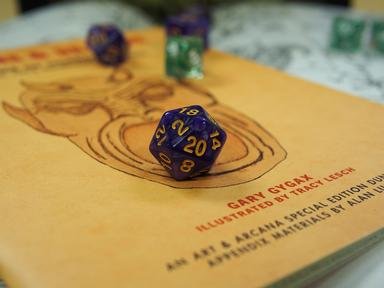Quiz Answer Key and Fun Facts
1. Although mostly focusing on providing rules for playing characters of levels 25-36 (the highest levels available to mortal characters), the Dungeons & Dragons Master Rules Set introduces several optional rules that can be used by characters of all levels. One of these options is a system called Weapons Mastery that allows characters to obtain greater skill in the use of specific weapons through special study. Once a character obtains basic mastery of weapon, it is possible to progressively achieve four higher levels of mastery. Which of the following is NOT one of these mastery levels?
2. In the lower levels rules sets, the only weapon that a magic-user could use is a dagger. An optional rule in the Master Set allows magic-users to wield several other weapons as well. Which of the following weapons would these rules not allow a magic-user to wield?
3. By the standard Dungeons & Dragons rules used in the lower level sets, the only ability that can affect a character's saving throws is their wisdom, and this only affects saving throws vs. spells. The Master Set includes an optional rule that allows most other ability scores to affect some other saving throws. Which ability does not affect any saving throws under these optional rules?
4. The Master Rules Set introduces a number of special rules for undead creatures. Intelligent undead may attempt to take control of other less powerful undead creatures. An undead that is under the control of another undead is called a pawn. What is the controlling undead called?
5. Another interesting rule for undead creatures, is that a character who is slain by an energy-draining undead creature (such as a wight or a vampire), will rise again later as the same type of undead creature under the control of the slayer. What would then happen to the victim if the slayer is subsequently destroyed?
6. The Master Rules Set gives detailed explanations of both anti-magic effects and the dispel magic spell, which each act to cancel magic. What is the main important difference between them?
7. The Master Rules Set gives detailed rules for siege warfare, with a particular focus on how defenders manage their resources. Which of the following cleric spells would be particularly useful to have access to when defending a castle against a siege?
8. Detailed rules for non-human spellcasters are provided in the Master Set. Non-human creatures who can cast cleric or druid spells are known as shamans. A non-human who can cast magic-user spells is known by what name, that also refers to a real-world religion?
9. As characters begin to approach the 36th level, they may become aware of transcendental beings known as the Immortals who manipulate events in the mortal world for their own secret goals. The Master Rules Set provides considerable information about the Immortals. For example, they each serve one of five Spheres of Power. Four of these spheres are each related to one of the four elements of fire, air, water, and earth. What is the name of the fifth sphere, which is associated with death?
10. Mortal characters who are sufficiently advanced may seek immortality through one of four paths, one for each of the four elemental spheres of power. The four paths are the Dynast, Epic Hero, Paragon, and Polymath. Demi-human characters may seek immortality through three of these paths, while only humans may attempt to become Immortals of which path?
11. All of the four pathways to immortality described in the Master Set involve several difficult requirements that must be met, including a quest and a trial. Which of the following is NOT a trial in one of the four pathways?
12. A new character class is introduced in the Master Set called the Mystic, which is a version of the monk class found in earlier versions of Dungeons & Dragons. What is the particular specialty of the Mystic?
13. Artifacts are extremely powerful magic items that have been created by Immortals, which are described in detail in the Master set. In addition to providing dungeon masters with guidelines for designing unique artifacts to include in their campaign settings, several examples inspired by myths and legends are described. One of these is the Pileus, an artifact of the Sphere of Energy, which takes the form of what ordinary object that has historically become associated with liberty?
14. The Master Set provides details of the lich, a very powerful type of undead spellcaster. Which of the following statements about a lich is untrue according to these rules?
15. Immortal Dragon Rulers are introduced in the Master Set: three lesser rulers who each rule over all dragons of a specific alignment (Lawful, Neutral, and Chaotic, respectively) and a Great One who rules over all dragon-kind. The three lesser rulers are each associated with a particular gemstone. Which of the following is NOT one of the three rulers?
Source: Author
agentofchaos
This quiz was reviewed by FunTrivia editor
WesleyCrusher before going online.
Any errors found in FunTrivia content are routinely corrected through our feedback system.
